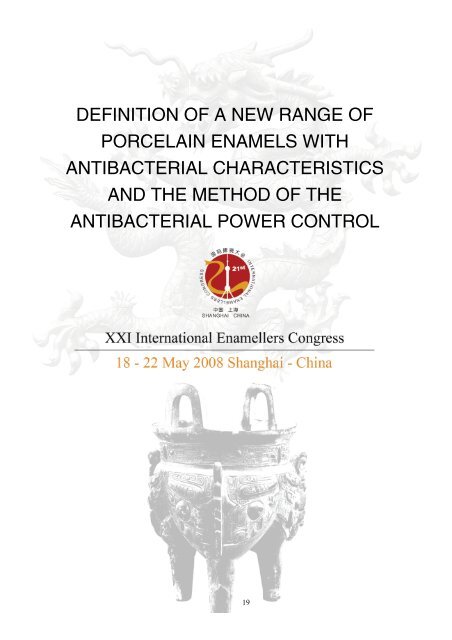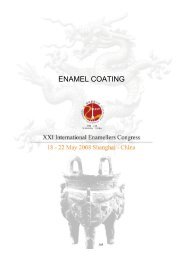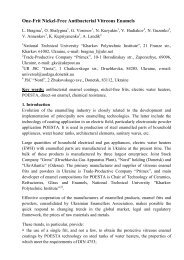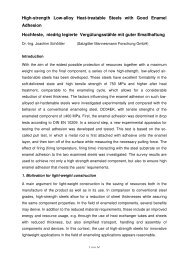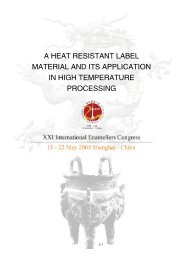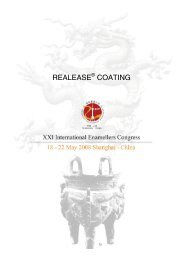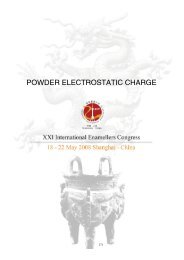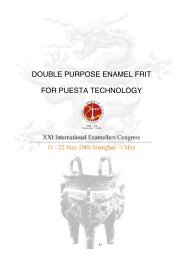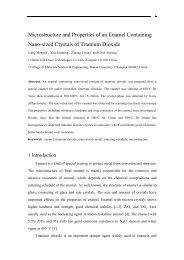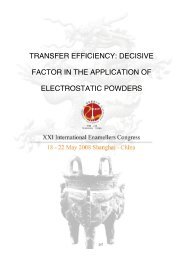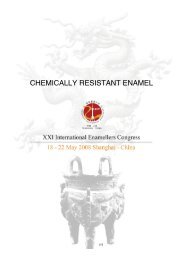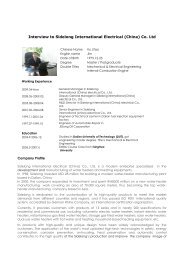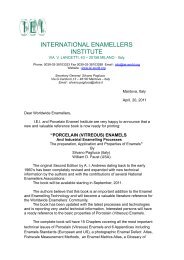definition of a new range of porcelain enamels with antibacterial ...
definition of a new range of porcelain enamels with antibacterial ...
definition of a new range of porcelain enamels with antibacterial ...
- No tags were found...
Create successful ePaper yourself
Turn your PDF publications into a flip-book with our unique Google optimized e-Paper software.
XXI International Enamellers CongressDefinition <strong>of</strong> a New Range <strong>of</strong> Porcelain Enamels <strong>with</strong>Antibacterial Characteristics and the Method <strong>of</strong> theAntibacterial Power ControlLuca Pignatti a , Andrea Zucchelli b , Raffaele Poletti a , Greta Rossi a , Alberto Chelli aa SMALTIFLEX S.p.A., via dell’Industria 115, 41038, San Felice sul Panaro (MO), Italiab UNIVERSITA’ DI BOLOGNA, DIEM, Facoltà di Ingegneria – viale Risorgimento 2,40136, Bologna, Italia1. IntroductionThe <strong>porcelain</strong> enamel is the covering <strong>of</strong> a glassy nature, historically used for its aesthetical andprotective functionality in respect to the action <strong>of</strong> aggressive factors. In particular, the <strong>porcelain</strong>enamelling <strong>of</strong> metals that in the past was used as the decorative work for jewels and moniles andonly in the XVIII. century began its use to protect metals from the corrosion. Nowadays this materialis <strong>of</strong> common use in many areas <strong>of</strong> engineering and especially it’s appreciated as a protectivecovering <strong>of</strong> the metal surfaces, so as to protect them against the corrosion <strong>of</strong> numerous chemicaland atmospheric factors.The purpose <strong>of</strong> this work is to extend functional capacity <strong>of</strong> such covering in terms <strong>of</strong> resistance tothe biological factors, in particular to the bacteria. These, beyond to be able to attack the materials,among which the metals, through the corrosive production <strong>of</strong> bi<strong>of</strong>ilm 1,2,3,4 , represent serious and<strong>of</strong>ten undervalued risk for the human, animal and phytological health. 5Unfortunately, the <strong>porcelain</strong> enamel for the metals appears to be, to this day, not much studied andfew works <strong>with</strong> this argument don’t treat its <strong>antibacterial</strong> characteristics, for less than one study byMarzullo 6 that recognises innate and superior <strong>antibacterial</strong> characteristic <strong>of</strong> this material in respect tothe others. Last years this problem has attracted attention <strong>of</strong> some research group 7 , but <strong>with</strong>outproduction <strong>of</strong> the full works both <strong>of</strong> methodological functional point <strong>of</strong> view and industrial application.This group <strong>of</strong> the research already active in other studies about mechanical tribologicalcharacteristics <strong>of</strong> <strong>porcelain</strong> enamel for metals 7,8,9,10,11 , has given an idea to improve considerablyreply <strong>of</strong> <strong>porcelain</strong> <strong>enamels</strong> conveniently formulated in respect to bacteria, both in terms <strong>of</strong> velocity <strong>of</strong><strong>antibacterial</strong> action, and <strong>of</strong> its duration in time, defining at the same time strong method to evaluate<strong>antibacterial</strong> power. To this day the analyse method the most qualified for evaluation <strong>of</strong> the<strong>antibacterial</strong> power <strong>of</strong> the surface is described in the norm JIZ Z 2801:2000. This method, at leastprovisionally in this application case, isn’t immune to the problems and in the next paragraphs is alsosuggested alternative and optimised method based on what is given in Pfaller et Al. 7 .Leaving from the formulations in oxides <strong>of</strong> standard <strong>porcelain</strong> <strong>enamels</strong> that have already for itselfaesthetic- functional specific characteristics, it was made a careful analysis <strong>of</strong> the literature regardingthe capacity to interfere <strong>with</strong> bacterial proliferation by the side <strong>of</strong> metallic oxides <strong>of</strong> the common orextraordinary use in the ceramic area. In particular, there was found a number <strong>of</strong> studies which deal<strong>with</strong> the <strong>antibacterial</strong> activity <strong>of</strong> some metallic cations in solution or <strong>of</strong> some ceramic powders movedalong in different matrix or in massive form 7 . The best known <strong>antibacterial</strong> inorganic factor iscertainly Silver oxide (Ag 2 O), <strong>of</strong> which properties are defined as oligodynamic. This term indicatesthat silver is active even if it’s present in very low concentrations. It is used <strong>with</strong> success as addition20
Definition <strong>of</strong> a New Range <strong>of</strong> Porcelain Enamels <strong>with</strong> AntibacterialCharacteristics and the Method <strong>of</strong> the Antibacterial Power Control<strong>of</strong> metals used for the construction <strong>of</strong> the water tanks in public field and in past its salt was used todisinfect injures 7,8,9,10,11 . The other oxide, where are recognized <strong>antibacterial</strong> characteristics is rameicoxide (CuO), that for such characteristic is now <strong>of</strong> normal engagement in diverse fields. The mostrecent began the study <strong>of</strong> action mechanism <strong>of</strong> this element in contrast <strong>with</strong> the bacterialproliferation. It seems that in certain aquatic fields is active under form <strong>of</strong> Cu 2+ already inconcentration <strong>of</strong> 10 μg l -1 . However, in order to study the composition <strong>of</strong> battericides supports, mustbe bear in mind more recent works that have demonstrated how the total quantity <strong>of</strong> Cu(II) isn’tdirectly connected to the bacterial activity, but like the previous depends solely on the presence <strong>of</strong>Cu 2+ free in the solution <strong>of</strong> decontamination absorbed by E. coli e S. aureus, damaging irreparablyits structure 7 . This quantity is measured through pCu 7,8,9 More recently only, thanks intensive studyin fields <strong>of</strong> catalise it was discovered <strong>antibacterial</strong> power <strong>of</strong> TiO 2 . The titanium oxide is considered<strong>antibacterial</strong> in so far factor that activated fotocatalitical reactions, through radiation <strong>with</strong> UV, thatdamage organic compounds, even those contained in cells. The number <strong>of</strong> studies is available aboutfotocatalitical effects on different microorganisms <strong>of</strong> TiO 2 on powder or nano-dust, moved-along insolutions or like covering for the fotocatalitical surfaces 7,8,9,10,11,12 . There are evidences 7,8,9,10 <strong>of</strong> thefact that fotocatalitical activity causes lipids peroxidation <strong>of</strong> the cellular membranes andsubsequently <strong>of</strong> the intracellulare material, in way to kill the bacteria. Even if other coverings,different from that proposed here, have already demonstrated excellent foto-biocide capacity 7 theypresent the necessity <strong>of</strong> being activated through radiation UV. In addition according to Sawai etAl. 7,8,9,10,11 even ZnO would have some type <strong>of</strong> interaction <strong>with</strong> the bacteria, even if this would beconsidered bacteriostatico rather than bactericida. This reacts <strong>with</strong> major efficacy on Gram-positivebacteria and its action would attribute the interactions on surface <strong>of</strong> liquid-solid interface, in fact zincis scarcely soluble and moreover it was noticed how increasing the fineness <strong>of</strong> the particles,increases also the bacteriostatical activity. Superficial moisturizing, thanks which are formed on thesurface the groups <strong>of</strong> -OH, plays an important role in <strong>antibacterial</strong> activity: is sensible to the heattreatments<strong>of</strong> high temperatures (1023K), that cause non hydrate structure stabilization (63%) inbond Zn-O. From other works <strong>of</strong> the same group emerge that the action mechanism <strong>of</strong> ZnO could becorrelated to damage <strong>of</strong> ribosoms in cell <strong>of</strong> E. coli. What could derive from fact that ZnO createsH 2 O 2 . In regard is mention also the <strong>new</strong> certificate (WO 2006/088468 A2) <strong>of</strong> a <strong>new</strong> <strong>porcelain</strong> enamelfor ceramic and metals zinc oxide containing and zinc borate having antimicrobical characteristics.It’s related finally as much as affirmed in one interesting comparative study between quartz, zincoxide and titanic oxide 7 in nanometrical form. Here the authors attribute even though not so high butimportant antimicrobical power to nanometrical crystal silice. This peculiarity <strong>of</strong> the silice could becorrelated on raw antimicrobical power <strong>of</strong> the <strong>porcelain</strong> enamel introduced at the beginning.How it’s hitherto affirmed, it can be said that the capacity <strong>of</strong> the inorganic oxide to act likeantibactecal could depend on the following phenomena:1. transfer <strong>of</strong> antibacterical factors, under form <strong>of</strong> cations, to the solution containing bacteria;2. oxidation by fotocatalitical way<strong>of</strong> the organic compounds from which bacteria are constituted;3. production by catalitical way <strong>of</strong> oxidant factors like H 2 O 2 .This work consecutively described, has an objective to study <strong>antibacterial</strong> efficacy <strong>of</strong> these and othersubstances when they enter to be part <strong>of</strong> the constitutional elements <strong>of</strong> the covering <strong>of</strong> the <strong>porcelain</strong>enamel for metals.21
XXI International Enamellers Congress2. Experimatal details2.1 Preparation <strong>of</strong> samplesThrough the specific techniques <strong>of</strong> <strong>porcelain</strong> enamel field, were made and applied three differentcoverings: AMB1 (white <strong>porcelain</strong> enamel), AMB2 (<strong>porcelain</strong> enamel for water heaters), AMB3(antiacid <strong>porcelain</strong> enamel).When barbottines (slip) was obtained, coverings were applicated on substrated ultra low carbonsteel DC04ED which form recovers the capsule Petri. One example <strong>of</strong> this capsule follows in Fig. 1.Fig. 1 Drawing <strong>of</strong> the pseudo-capsule Petri used for the microbiological testThe samples were then be fired for 6’30’’ at 850°C. Pre-emptively, in order to evaluate the analyticalmethod, one set <strong>of</strong> pseudo-capsule Petri was covered <strong>with</strong> standard <strong>porcelain</strong> enamel that containedno <strong>antibacterial</strong> factor and denominated NEUTRAL.2.2 Method <strong>of</strong> <strong>antibacterial</strong> activity analysisData obtained from this work <strong>of</strong> research are based on the microbiological test expressly created soas to minimize the experimental mistake and to speed up analysis. Grounding on what described inthe technical norm JIS Z 2801: 2000 and in recommendation <strong>of</strong> National Committee for ClinicalLaboratory Standards (NCCLS) in matter <strong>of</strong> Time-Kill Method as mentioned above, was establisheda method <strong>of</strong> action <strong>antibacterial</strong> analysis <strong>of</strong> surface in function <strong>of</strong> time, that confirmed a strong andfast application. It’s fundamental step to produce pseudo-capsule Petri, <strong>of</strong> which internal surface incontact <strong>with</strong> broth containing the bacterial colony is made and covered by material <strong>of</strong> which will betested <strong>antibacterial</strong> capacity. The test were conducted using bacterial suspensions in APT and inphysiological, di Escherichia coli e Staphylococcus aureus, prepared according to a normalmicrobiological standard having concetration <strong>of</strong> 10 8 CFU/ml. At the beginning <strong>of</strong> each test the knownquantity <strong>of</strong> two bacterial suspensions, usually 10 ml or the sufficient volume to cover all the capsulesurface, it was inoculated in covered pseudo-capsule Petri and in standard capsule Petri, thatrappresent white test and were placed to incubate both in presence <strong>of</strong> light and darkness in 37°C.Leaving from zero (moment <strong>of</strong> inocule) and subsequently to set intervals <strong>of</strong> 6, 20 e 72 hours, weredrawn rates <strong>of</strong> 100 μL <strong>of</strong> bacterial suspension directly from capsule submitted to a test and CFUresidual were counted by technique <strong>of</strong> agar plate count. The variant <strong>of</strong> described method consists inusing bacterial suspension <strong>of</strong> 10 3 CFL/ml in APT <strong>with</strong> which test the sample NEUTRAL, in order todesperse each doubt in goodness <strong>of</strong> the proposed technique, once verified equivalence <strong>of</strong>multiplicative capacity <strong>of</strong> bacteria in this samples and capsule Petri. For this version samplings weremade in 0.2, 1, 2, 3, 4, 20 e 72 hours .22
Definition <strong>of</strong> a New Range <strong>of</strong> Porcelain Enamels <strong>with</strong> AntibacterialCharacteristics and the Method <strong>of</strong> the Antibacterial Power Control3. Results and discussion3.1 Stoutness <strong>of</strong> the methodTo control the efficacy <strong>of</strong> analyse method <strong>of</strong> the capacity <strong>of</strong> bacterial charge fall, proposed test wasconducted also in its variant <strong>with</strong> bacterial concentration <strong>of</strong> 10 3 CFU/ml, in parallel <strong>with</strong> NEUTRALenamel, which composition is limited to the minimum <strong>of</strong> constituting oxides, and on the set <strong>of</strong> Petricapsules. The test were conducted <strong>with</strong> 5 repetitions every single one. On the Graphs 1 is clearlyshown how process <strong>of</strong> growing curves <strong>of</strong> E. coli in APT <strong>with</strong> the initial concentration <strong>of</strong> 10 3 CFU/ml,varying conditions <strong>of</strong> lightness and darkness, is completely equivalent for two types <strong>of</strong> capsules.Processes completely similar were obtained for S. aureus. Limited case, is given by experimentalevidence that, as in the Petri capsule, as in that covered <strong>with</strong> NEUTRAL, bacterial suspensions inAPT having initial concentrations <strong>of</strong> 10 8 CFU/ml, bring already after few hours, to the formation <strong>of</strong>extended bacterial coat and non accounting.E. coli, APT, 37°C, light12Log (CFU/ml)10864E.coli, NEUTROE.coli, Petri20[0,2h 1h 2h 3h 4h 20h 72h]Time (h)E.coli, APT, 37°C, darkness12Log (CFU/ml)10864E.coli, NEUTROE.coli, Petri20[0,2h 1h 2h 3h 4h 20 72h]Time (h)Graph 1 Growing curve <strong>of</strong> E. coli in APT in NEUTRAL and Petri capsule3.2 Evaluation <strong>of</strong> the <strong>antibacterial</strong> capacityExperimental data obtained for three types <strong>of</strong> covering, submitted to an analyse <strong>with</strong> bacterialsuspensions in physiological solutions and in APT, are respectively related in Schedule 2 e inSchedule 3. Moreover, Graphs 2, 3 describe process <strong>of</strong> the growing curves for E. coli e S. aureus inphysiological solution and APT for enamel AMB3, which gave the best results.23
XXI International Enamellers CongressEnamel Conditions Bacteria strain 15 min (Log CFU/ml) 6 hours (Log CFU/ml) 20 hours (Log CFU/ml) 72 hours (Log CFU/ml)AMB1 Light E.coli 8.34 8.03 5.98 5.82Petri 8.16 8.09 7.75 7.64Darkness E.coli 8.36 8.12 6.07 6.01Petri 8.42 8.22 7.83 7.51Light S.aureus 8.11 7.26 6.21 5.36Petri 8.17 7.81 7.65 7.23Darkness S.aureus 8.01 7.04 5.94 5.01Petri 8.30 8.21 8.08 7.49AMB2 Light E.coli 8.22 5.08 1.36 0.45Petri 8.14 8.06 7.29 7.25Darkness E.coli 8.24 5.11 1.45 0.85Petri 8.34 8.16 7.49 7.33Light S.aureus 8.09 1.97 1.40 -0.02Petri 8.32 7.11 7.02 6.75Darkness S.aureus 8.12 2.65 1.75 0.98Petri 8.34 7.56 7.35 7.21AMB3 Light E.coli 8.34 4.78 0.95 -0.05Petri 8.26 8.18 7.78 7.74Darkness E.coli 8.36 4.91 0.95 -0.05Petri 8.45 8.26 7.79 7.56Light S.aureus 8.11 0.95 1.30 -0.05Petri 8.30 8.15 8.12 7.98Darkness S.aureus 8.01 0.95 0.95 0.78Petri 8.30 8.21 8.01 7.85Schedule 2 Results <strong>of</strong> the fall test <strong>of</strong> E. coli ed S. aureus in phisiological solutionsEnamel Conditions Bacteria strain 15 min (Log CFU/ml) 6 hours (Log CFU/ml) 20 hours (Log CFU/ml) 72 hours (Log CFU/ml)AMB1 Light E.coli 8.16 n.c. patina n.c. patina n.c. patinaPetri 8.24 n.c. patina n.c. patina n.c. patinaDarkness E.coli 8.62 n.c. patina n.c. patina n.c. patinaPetri 8.41 n.c. patina n.c. patina n.c. patinaLight S.aureus 8.17 n.c. patina n.c. patina n.c. patinaPetri 8.19 n.c. patina n.c. patina n.c. patinaDarkness S.aureus 8.34 n.c. patina n.c. patina n.c. patinaPetri 8.30 n.c. patina n.c. patina n.c. patinaAMB2 Light E.coli 8.12 7.44 5.25 5.20Petri 8.26 n.c. patina n.c. patina n.c. patinaDarkness E.coli 8.31 6.99 5.71 5.64Petri 8.27 n.c. patina n.c. patina n.c. patinaLight S.aureus 8.39 7.36 5.40 4.76Petri 8.25 n.c. patina n.c. patina n.c. patinaDarkness S.aureus 8.25 7.34 5.81 4.42Petri 8.02 n.c. patina n.c. patina n.c. patinaAMB3 Light E.coli 8.31 7.18 5.05 5.00Petri 8.33 n.c. patina n.c. patina n.c. patinaDarkness E.coli 8.25 7.11 5.22 5.14Petri 8.41 n.c. patina n.c. patina n.c. patinaLight S.aureus 8.02 7.00 5.30 4.15Petri 8.33 n.c. patina n.c. patina n.c. patinaDarkness S.aureus 8.20 7.04 5.51 4.42Petri 8.27 n.c. patina n.c. patina n.c. patinaSchedule 3 Results <strong>of</strong> fall test <strong>of</strong> E. coli e S. aureus in APTAs it’s noted, all whites <strong>of</strong> test don’t give any interferences <strong>with</strong> bacterical activity, in line <strong>of</strong> what iscoherent waiting in optimal conditions. On the contrary, the curves obtained from the count <strong>of</strong>bacteria in suspension in physiological solution, inoculated in psedo-capsule Petri covered <strong>with</strong>AMB3, incubated in light and darkness, demonstrate fall <strong>of</strong> initial bacterial charge <strong>of</strong> at least threeorders <strong>of</strong> greatness. In particular the fall <strong>of</strong> E. coli in physiological solution, on the light and darkness,24
Definition <strong>of</strong> a New Range <strong>of</strong> Porcelain Enamels <strong>with</strong> AntibacterialCharacteristics and the Method <strong>of</strong> the Antibacterial Power Controlis resulted to be <strong>of</strong> three orders <strong>of</strong> greatness already after six hours <strong>of</strong> incubation, to arrive up to thefactor 10 7 after 20 hours.Log (CFU/ml)9876543210E. coli, fisiologica, 37°C, lightE. coli, AMB3E. coli, Petri[0,2 6 20 72]Time (h)Log (CFU/ml)9876543210E. coli, fisiologica, 37°C, darknessE. coli, AMB3E. coli, Petri[0,2 6 20 72]Time (h)Log (CFU/ml)987654321S. aureus, fisiologica, 37°C, lightS.aureus, AMB3S. aureus, PetriLog (CFU/ml)987654321S. aureus, fisiologica, 37°C, darknessS. aureus, AMB3S.aureus, Petri0[0,2 6 20 72]Time (h)0[0,2 6 20 72]Time (h)Graph 2 Process <strong>of</strong> the growing curves for E. coli e S. aureus in physiologic in AMB3For physiological S. aureus in, already after six hours <strong>of</strong> incubation, initial inocule was reduced to thefactor 10 7 .AMB3 Killing curves for E. coli and S. Aureus in APTLog (CFU/ml)8.508.258.007.757.507.257.006.756.506.256.005.755.505.255.004.754.504.254.00E. coli, lightE. coli, darknessS. aureus, lightS. aureus, darknessTime (h)Graph 3 Growing curves <strong>of</strong> E. Coli e S. aureus in APT in AMB3;points are referred to 0,2, 6, 20 e 72 hours <strong>of</strong> contact25
XXI International Enamellers CongressIn the case that two bacterial fettersesis APT instead, following their evolution in time, the contact<strong>with</strong> the coverig AMB3, in condition <strong>of</strong> lightness and darkness, giving a fall no more that onelogarithm after 6 hours and 3 logarithms after 20 hours respect to initial inocule; in 72 hours frominocule the sampling confirms the number stability <strong>of</strong> CFU counted for E. coli from previous sampling,while register ulterior fall for S. aureus, that is attested on the total reduction <strong>of</strong> factor 10 4 <strong>with</strong>respect to initial inocule. Even if the <strong>porcelain</strong> enamel AMB2 gave remarkable results in terms <strong>of</strong>contrast to bacterial proliferation, even if slightly inferior <strong>of</strong> that obtained for AMB3. Finally, enamelAMB1 is demonstrated to be more limited than other two, even having permit total fall <strong>of</strong> E. coli inphysiological solution, in lightness and darkness, <strong>of</strong> 2 logarithms after 20 hours that remainunchanged in 72 hours. Lightly better results were obtained in the same operative conditions for S.aureus, that was falled by the order <strong>of</strong> greatness after 72 hours. It must be register the missedefficacy <strong>of</strong> AMB1 towards 2 bacterial fetterses (Petri capsule), both in pseudo Petri covered <strong>with</strong> this<strong>porcelain</strong> enamel.4. ConclusionsThis work described in present document, not at all definitive, <strong>of</strong>fers <strong>new</strong> possibilities <strong>of</strong> the researchand <strong>of</strong> market for <strong>porcelain</strong> enamel for metals. In particular, shows in evident manner the possibilityto manipulate formulation <strong>of</strong> this ceramic coverings for obtaining <strong>new</strong> functional properties, like thecapacity <strong>of</strong> contrasting the bacterial proliferation. However, it’s necessary to persevere inexperimentation <strong>of</strong> the <strong>new</strong> <strong>antibacterial</strong> factors, as much as to conduct test on different bacterialfetterses. It’s noted finally how, beyond defining the precise and fast analytical method and <strong>of</strong>effective realization <strong>of</strong> the <strong>porcelain</strong> covering already industrializable, our study made possibledemonstration one more time <strong>of</strong> the effective capacity <strong>of</strong> some inorganic compounds contrastingbacterial proliferation, even after that these were heat treated in significant way and repeated andincluded in glassy amorphous matrix.References1. X. Munoz-Berbel, F.J. Munoz, N. Vigués, J. Mas, “On-chip impedance measurements to monitor bi<strong>of</strong>ilm formationin the drinking water distribution network”, Sens. Actuators, A 118 (2006) 129-134.2. I. B. Beech, “Corrosion <strong>of</strong> technical materials in the presence <strong>of</strong> bi<strong>of</strong>ilms: current understanding and state-<strong>of</strong>-the artmethods <strong>of</strong> study”, Int. Biodeterior. Biodegrad., 53 (2004) 177-183.3. M. Oliveira, R. Bexiga, S.F. Nunes, C. Carneiro, L.M. Cavaco, Vee, “Bi<strong>of</strong>ilm-forming ability pr<strong>of</strong>iling <strong>of</strong>Staphylococcus aureus and Staphylococcus epidermidis mastitis isolates”, Veterinary Microbiology, 118 (2006)133-140.4. Ji-Dong Gu, “Microbial colonization <strong>of</strong> polymeric materials for space applications and mechanisms <strong>of</strong>biodeterioration: A review”, Int. Biodeterior. Biodegrad., 59 (3) (2007) 170-183.5. D. Lindsay, A. von Holy, “Bacterial bi<strong>of</strong>ilms <strong>with</strong>in the clinical setting: what healthcare pr<strong>of</strong>essionals should know”,J. Hosp. Infect., 64 (2006) 313-325.6. Franco Marzullo, Indagine batteriologica comparata, CISP (available at www.cisp.it).7. E. Voß, C. Störch, “Bacteria growth evaluation on different materials”, International Enamellers Congress, Istanbul,(2005).8. A. Chelli, R. Poletti, L. Pignatti, A. Zucchelli, L. Rossetti, V. Dal Re, D. Prandstraller, S. Tiberi Vipraio, G.Palombarini, Studio delle Proprietà Meccaniche e Tribologiche di Lamiere in Acciaio rivestite mediante SmaltiPorcellanati, Smalto porcellanato n. 3, settembre-dicembre 2006.9. L. Rossetti, A. Zucchelli, V. Dal re, R. Poletti, A. Chelli, L. Pignatti, A Preliminary Study on the Flexural Strength <strong>of</strong>Porcelain Enameled Steel Composite Materials, 5th Youth Symposium on Experimental Solid Mechanics, May, 10-13 2006, Púchov, Slovakia.10. L. Rossetti1, A. Zucchelli1, G. Palombarini1, L. Brialdi1, S. Tiberi Vipraio, L. Pignatti, R. Poletti, Behavior toAbrasive Wear <strong>of</strong> White Enameled Extra Low Carbon Steel Sheets, 6th Youth Symposium on ExperimentalSolid Mechanics, May, 9-12 2007, Vrnjačka Banja, Serbia.26
Definition <strong>of</strong> a New Range <strong>of</strong> Porcelain Enamels <strong>with</strong> AntibacterialCharacteristics and the Method <strong>of</strong> the Antibacterial Power Control11. L. Rossetti, A. Zucchelli, V. Dal Re, Caratterizzazione a Flessione e a Trazione di Rivestimenti Ceramico-VetrosiApplicati a Substrati Metallici, Associazione Italiana per l’Analisi delle Sollecitazioni (AIAS), XXXVI ConvegnoNazionale – 4-8 Settembre 2007, Università degli Studi di Napoli Federico II – Seconda Università degli Studi diNapoli.12. A. Zucchelli, G. Palombarini, F. Tarterini, L. Pignatti, R. Poletti, A. Pirazzoli, Self-Healing Concept to Improve theMechanical Performance <strong>of</strong> Vitreous Enamel Coated Steel, First International Conference on Self HealingMaterials, 18-20 April 2007, Noordwijk, The Netherlands.13. M. A. Pfaller, D. J. Sheehan, J. H. Rex, “Determination <strong>of</strong> fungicidal activities against yeasts and molds: lessonslearned from bactericidal testing and the need for standardization”, Clinical Microbiolgy Reviews (2004) 268 – 280.14. F. Heidenau, W. Mittelmeier, R. Detsch, M. Haenle, F. Stenzel, G. Ziegler, H. Gollwitzer, “A novel <strong>antibacterial</strong>titania coating: Metal ion toxicity and in vitro surface colonization”, J. Mater. Sci. - Mater. Med., 16 (2005) 883-888.15. Höll, Karl, Grohmann, Andreas (Hrsg.), (2002), “Wasser: Nutzung im Kreislauf, Hygiene, Analyse und Bewertung“,8. Edition, de Gruyter Publishing House, Berlin & New York.16. Beck, Ernst G., Schmidt, Pavel, (1996), “Hygiene: Umweltmedizin“, 100 Tabellen 6. Edition, Ferdinand EnkePublishing House, Stuttgart.17. Borneff, Joachim, Borneff, Marianne, (1991), “Hygiene: Ein Leitfaden für Studenten und Ärzte“, 5. Auflage,Thieme Publishing House, Stuttgart & New York.18. Wallhäußer, Karl Heinz (1985), “Praxis der Sterilisation-Desinfektion-Konservierung- Keimidentifizierung-Betriebshygiene“, 4. Edition, Thieme Publishing House, Stuttgart & New York.19. M. Fang, J. H. Chen, X. L. Xu, P. H. Yang, H. F. Hildebrand, “Antibacterial activities <strong>of</strong> inorganic agents on sixbacteria associated <strong>with</strong> oral infections by two susceptibility tests”, Int. J. Antimicrob. Agents, 27 (2006) 513-517.20. Z. G. Dan, H. W. Ni, B. F. Xu, J. Xiong, P. Y. Xiong, “Microstructure and <strong>antibacterial</strong> properties <strong>of</strong> AISI 420stainless steel implanted by copper ions”, Thin Solid Films, 492 (2005) 93-100.21. L. J. Albright, J.W. Wentworth, E.M. Wilson, “Technique for measuring metallic salt effects upon the indigenousheterotrophic micr<strong>of</strong>lora <strong>of</strong> a natural water”, Water Research, 6 (12) (1972) 1589-1596.22. R. B. Jonas, “Acute copper and cupric ion toxicity in an estuarine microbial community”, Appl. Environ. Microbiol.,1 (1989) 43-49.23. C. H. Hu, M. S. Xia, “Adsorption and <strong>antibacterial</strong> effect <strong>of</strong> copper-exchanged montmorillonite on Escherichia coliK 88” Appl. Clay Sci., 31 (2005) 180-184.24. H. Tao, W. Wei, S. Zhang, “Photocatalytic inhibitory effect <strong>of</strong> immobilized TiO2 semiconductor on the growth <strong>of</strong>Escherichia coli studied by acoustic wave impedance analysis”, J. Photochem. Photobiol., A, 161 (2004) 193-199– note 1-9 dello stesso.25. J. C. Yu, W. Ho, J. Lin, H. Yip, P. K. Wong; “Photocatalytic activity, <strong>antibacterial</strong> effect, and photoinducedhydrophilicity <strong>of</strong> TiO2 tilms coated on a stainless steel substrate”, Environ. Sci. Technol., 37 (2003) 2296-2301.26. E. D. Wolfrum, J. Huang, D. M. Blake, P. C. Maness, Z. Huang, J. Fiest, “photocatalytic oxidation <strong>of</strong> bacteria,bacterial and fungal spores, and model bi<strong>of</strong>ilm components to carbon dioxide on titanium dioxide-coatedsurfaces”, Environ. Sci. Technol., 36 (2002) 3412-3419.27. A. L. Linsebigler, G. Lu, J. T. Yates, “Photocatalysis on TiO2 surfaces: principles, mechanisms, and selectedresults”, J. Chem. Rev., 95 (1995) 735-758.28. C. C. Trapalis, M. Kokkoris, G. Perdikakis, G. Kordas, “Study <strong>of</strong> <strong>antibacterial</strong> composite Cu/SiO 2 thin coatings”, J.Sol-Gel Sci. Technol., 26 (2003) 1213-1218.29. A. Mills, S. Le Hunte, “An overview <strong>of</strong> semiconductor photocatalysis”, J. Photochem. Photobiol., A, 108 (1997) 1-35.30. M. A. Fox, M.T. Dualy, “Heterogeneous photocatalysis”, Chem. Rev., 93 (1993) 341-357.31. D. M. Blake, P. C. Maness, Z. Huang, E. J. Wolfrum, J. Huang, W. A. Jacoby. “Application <strong>of</strong> the photocatalyticchemistry <strong>of</strong> titanium dioxide to disinfection and the killing <strong>of</strong> cancer cells”, Sep. Purif. Methods, 28 1 (1999): 1-50.32. W. A. Jacoby, P. C. Maness, E. J. Wolfrum, D. M. Blake, J. A. Fennel, “Mineralization <strong>of</strong> bacterial cell mass on aphotocatalytic surface in air”, Environ. Sci. Technol., 32 (1998) 2650-2653.33. Z. Huang, P. C. Maness, D. M. Blake, E. J. Wolfrum, S. L. Smolinski, W. A. Jacoby, “Bactericidal mode <strong>of</strong> titaniumdioxide photocatalysis”, J. Photochem. Photobiol., A, 130 (2000) 163-170.27
XXI International Enamellers Congress34. H. M. Yates, L. A. Brook, I. B. Ditta, P. Evans, H. A. Foster, D.W. Sheel, A. Steele, “Photo-induced self cleaningand biocidal behaviour <strong>of</strong> titania and copper oxide multilayers”, Journal <strong>of</strong> Photochemistry and Photobiology A:Chemistry (2007), doi:10.1016/j.jphotochem.2007.12.02335. J. Sawai, H. Igarashi, A. Hashimoto, K. Kokugan, M. Shimizu, “Evaluation <strong>of</strong> growth inhibitory effects <strong>of</strong> ceramicpowder slurry on bacteria by conductance method”, J. Chem. Eng. Japan, 28 (1995) 288-293.36. J. Sawai, H. Igarashi, A. Hashimoto, K. Kokugan, M. Shimizu, “Effect <strong>of</strong> ceramic powder slurry on spores <strong>of</strong>Bacillus subtilis”, J. Chem. Eng. Japan, 28 (1995) 288-293.37. J. Sawai, H. Igarashi, A. Hashimoto, K. Kokugan, M. Shimizu, “Effect <strong>of</strong> particle size and heating temperature <strong>of</strong>ceramic powders on <strong>antibacterial</strong> activity <strong>of</strong> their slurries”, J. Chem. Eng. Japan, 29 (2) (1996) 251-256.38. J. Sawai, E. Kawada, F. Kanou, H. Igarashi, A. Hashimoto, T. Kokugan, M. Shimizu, “Detection <strong>of</strong> active oxygengenerated from ceramic powders having <strong>antibacterial</strong> activity”, J. Chem. Eng. Japan, 29 (4) (1996) 627-633.39. J. Sawai, H. Kojima, H. Igarishi, A. Hashimoto, S. Shoji, A. Takehara, T. Sawaki, T. Kokugan, M. Shimizu,“Eschericia coli damage by ceramic powder slurries”, J. Chem. Eng. Japan, 30 (6) (1997) 1034-1039.40. L. K. Adams, D. Y. Lyon, P. J. J. Alvarez, “Comparative eco-toxicity <strong>of</strong> nanoscale TiO2, SiO2, and ZnO watersuspensions”, Water Res., 40 (2006) 3527-3532.28


